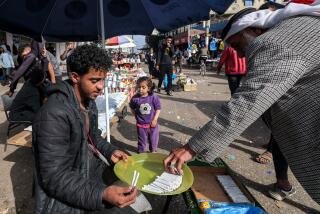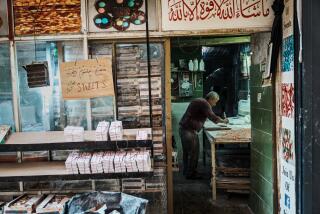Darfur war, mismanagement threaten key Sudan industry
- Share via
Umm Ruwaba, Sudan — FARMERS here call these sandblasted acacia orchards the “gardens of our grandfathers,” and for centuries the sticky amber sap flowing from them helped to bind civilization.
Egyptian pharaohs used the stuff for hieroglyphic ink. Red Sea traders carried it to Europe, where it was used in oils and became known, somewhat inaccurately, as “gum arabic” because buyers believed it originated in the Middle East.
Today Sudan accounts for more than 60% of the world market in the all-purpose tree sap. Gum arabic from these fields of central Sudan keeps the ingredients of Coke from separating in the can; it allows Altoid mints to lock in that “curiously strong” flavor; it keeps oil and water mixed together in a stick of margarine and prevents mascara from clumping in the tube.
Gum arabic is so vital to Western consumers that U.S. lawmakers carved out an exemption for the commodity after President Clinton first imposed trade sanctions against Sudan in 1997, despite reports that Osama bin Laden had once dabbled in the industry. When President Bush recently tightened economic sanctions against Sudan to protest the conflict in Darfur, gum arabic suppliers were once again left off the list of targeted firms. The U.S. buys about one-quarter of Sudan’s gum arabic.
The ancient industry is facing its biggest threat yet because of the conflict in Darfur and government mismanagement. Its future could affect not only the nearly 5 million Sudanese whose livelihoods depend upon the commodity, but also the price, quality and availability of hundreds of popular Western consumer products.
Since the war began between Darfur rebels and government-supported militias, known as janjaweed, harvesting has been difficult, if not impossible, in western Sudan, which accounted for a quarter of the country’s gum arabic production.
Desperate displaced families in Darfur have resorted to cutting down trees for charcoal or firewood. What little gum arabic that can be produced in the volatile region is now smuggled across the border into Chad.
The conflict, termed genocide by the U.S., has resulted in more than 200,000 deaths since 2003, mostly from disease and hunger, and displaced 2 million people.
Last year, exports by Sudan’s government-controlled Gum Arabic Co. fell to the lowest level on record, to less than 9,000 metric tons, compared with 30,000 tons in recent years and a peak of 50,000 in the 1960s.
The slump in sales has led to an unprecedented gum glut, forcing prices paid to farmers down so low that many say they won’t bother to harvest this year.
Farmer Abdul Rahman, 65, said the current government-set price for a 100-pound sack of gum arabic was $37 versus the $225 he received five years ago. Harvesting is still done by hand. After making long cuts in the thorny trunks and branches, workers return three weeks later to pluck off the golden, crusty balls of gum that ooze to heal the wound.
Rahman is worried he’ll barely earn enough this year to pay laborers. “It’s not worth it anymore,” he said. He and other local farmers say they may turn their attention to other crops, such as corn and sorghum, until gum prices rebound.
The village of Umm Ruwaba is a company town, and gum arabic has sustained the local economy for as long as anyone can remember. But lately there are fewer harvesting jobs for unskilled workers. Gum farmers sit idle in the main marketplace, pondering their next move. The once-bustling trading outposts are vacant except for the dusty stacks of 100-pound bags that nobody wants to buy.
“We’re a simple people and don’t understand what’s going on,” said Mustafa Musat, 53, a gum arabic trader in Umm Ruwaba. He said he suspected the slump was related to the Sudanese government’s troubled relations with the international community over Darfur and other issues. “All I know is that when relations with America were good, prices were very high,” he said.
Experts say the industry’s biggest obstacle is government regulation. Though gum arabic trees are privately owned, most exports must be funneled through Gum Arabic Co., which is 30% owned by the government. In practice, the government has been able to control the industry, along with the handful of private exporters.
“It’s like a cartel,” said one gum arabic industry executive, who was not authorized by his company to speak publicly.
In recent years, the international market for gum arabic has been characterized by unpredictable swings in prices and production. A shortage in 2003 pushed prices in the international market to record highs of $5,000 a ton, up from an average of about $1,200. Last year, despite the glut, average prices offered by Gum Arabic Co. were about $2,200 a ton, according to company documents.
Sudanese officials blamed the 2003 shortage on drought, but buyers and academics suspected manipulation.
“It wasn’t a natural occurrence,” said Chris Berliner, vice president of New Jersey-based Importers Service Corp., one of the biggest gum arabic importers in the U.S. “Artificial market forces were inflating prices.”
As a result, Importers Service and other international buyers began to look elsewhere. Chad, Nigeria, Uganda and Ethiopia are ramping up their production. Berliner said his firm shifted part of its business to the few private sellers in Sudan. Others began searching for lab-produced substitutes that can mimic the properties of gum arabic.
“The government ended up frustrating buyers and driving them away,” said Huda Sharawi, assistant professor in the University of Khartoum’s department of forest products.
She said reforms were needed to reduce government control and clear the path for privatization, including allowing farmers to form cooperatives and sell directly to buyers. The government should also lift nearly a dozen different taxes and fees on production, which cut into profits, Sharawi said.
An executive at Gum Arabic Co., who spoke on condition of anonymity, said the company was confident that sales and prices would rebound.
“The company has shareholders like anybody else, and they don’t want to sell at a loss,” the executive said. Though other countries are increasing production, Sudan’s acacia trees yield a higher-quality gum that buyers prefer, he said. “Customers will come back.”
Revenue from Sudan’s gum arabic totals less than $80 million a year, far less than the $4 billion to $6 billion the country receives from oil production. But experts caution against underestimating the commodity and the leverage it could provide in the West.
“Money-wise it’s not that important,” said Abdel Azim Yassim Abdel Gadir, a dean in the University of Khartoum’s forestry department. “But the commodity is important, particularly to developed countries.”
The industry slump could also have environmental consequences, particularly if farmers opt to chop down trees and replace orchards with other crops. The Acacia senegal tree, a source of the gum, is found chiefly in a belt of Africa stretching from Ethiopia to Senegal.
In Sudan, the trees function as a shield against the encroaching sub-Saharan desert, keeping soil fertile and blocking sandstorms, according to Abdul Hamied, who is in charge of gum arabic for the Ministry of Agriculture and Forestry.
“It’s like a wall facing the desert,” Hamied said. “They are one of the most important trees in terms of desertification control.”
His department is working with environmental groups to discourage farmers from cutting down the trees and replanting.
The industry also plays an important role in job production and poverty control, he said. An estimated 5 million Sudanese work in the industry, mostly small farmers and laborers.
In Umm Ruwaba in March, only a few could be seen working in the sprawling gum forests, despite the fact that it was a key harvest month.
“Normally these fields would be crowded,” said Adil Bashire, 38, whose ancestors harvested gum. He said he was thinking about planting sesame and criticized the government’s inaction.
“The government has so many problems with everyone else in the world,” he said. “We are the ones paying for it.”
--
(BEGIN TEXT OF INFOBOX)
Hundreds of uses
--
What is gum arabic?
A sap that oozes from two species of acacia trees when the surface is scarred or the bark pulled off.
Where does it come from?
A narrow strip of Africa just south of the Sahara. Top producing countries are Sudan, Chad and Nigeria.
What is it used in?
Soft drinks, baked goods, candy, beer, marshmallows, shoe polish, medicines, cosmetics, printing inks.
Why is it valuable?
It is a high-quality emulsifier and binder that helps ingredients stay properly mixed.
How is it used?
In beverages, it stabilizes citrus-flavored mixtures and limits foaming. In candy, it retards sugar crystallization and helps fat mix for a uniform texture. In pharmaceuticals, it binds medicines into tablets or syrups. In cosmetics, it provides a protective coating and a smooth feel.
Times research by Scott J. Wilson
More to Read
Sign up for Essential California
The most important California stories and recommendations in your inbox every morning.
You may occasionally receive promotional content from the Los Angeles Times.










